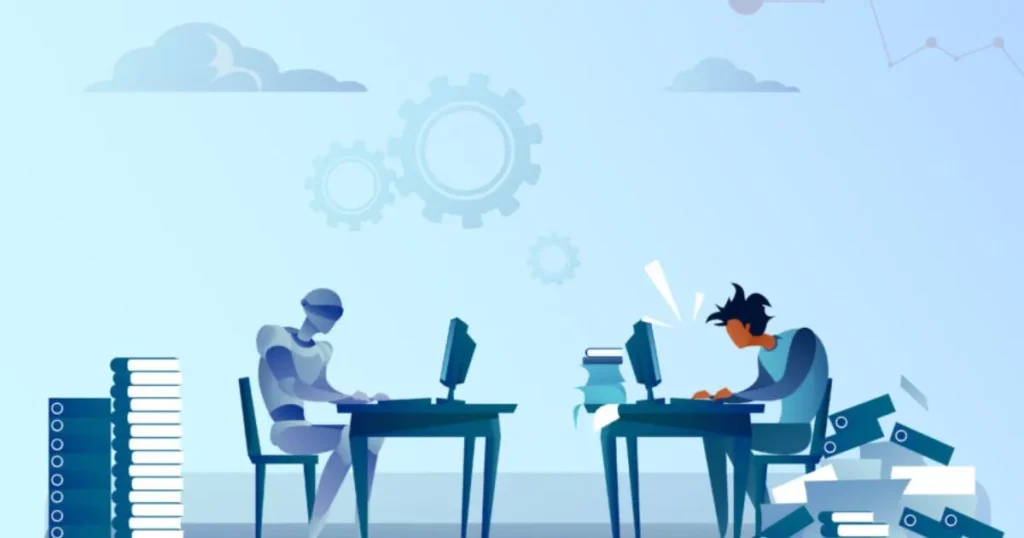The far-reaching consequences or adverse effects of the robot revolution in the field of employment have always been exaggerated. The truth is that artificial intelligence is not taking away jobs, it is replacing them.
The ability of Artificial Intelligence to recognize and learn from the various available data patterns has provided tremendous edge to various organizations. During the pandemic we have seen robots being used to sanitize hospitals corridors and also in delivering sensitive blood samples to medicines across health sectors.
There are also less robotic looking Artificial Intelligence tools which is utilized by the organizations to ensure the fate of any newly launched product. AI tools to meet the challenges posed by a move away from physical consumerism to digital, including technology that predicts people’s financial outlook and “try-before-you-buy” product-matching systems.
There are implications for humans, though. According to a World Economic Forum forecast, in a shift likely to worsen inequality, half of all work tasks will be handled by machines by 2025. A separate report from the Massachusetts Institute of Technology projects AI could replace as many as two million more workers in manufacturing alone by 2025.
This shift, coupled with an economic downturn, is paving the way for fresh concerns from employees about how many jobs will be lost to automation, especially for those in the services, electronic and manufacturing industries. In the United States alone, a little over a quarter (27 per cent) of all workers say they are worried the job they have now will be eliminated within the next five years as a result of new technology, robots or AI.
Improving the working experience
Tech behemoth Cisco is leveraging AI, machine learning and smart data to enhance the quality of remote working for its 75,000 staff, from engineers to sales reps.
With 96 per cent of employees currently working away from the office and a hybrid working model here to stay for the long-term, it has been using deep-learning algorithms to power an “empathetic, inclusive, secure, work-from-anywhere” experience, says senior director of people and communities Gianpaolo Barozzi.
Solutions include use of intelligent video so people can move around freely in their workspace and still be available in meetings, as well as real-time meeting transcription and automated debriefs.
Identifying human gaps, instead of filling them
Marketing giant Publicis Groupe credits the use of its internal AI application Marcel for helping it save 2,000 jobs during the pandemic. As a result, it plans to spend more heavily on the tool, having seen an encouraging impact on its workforce.
The smart intranet works by assigning relevant briefs and projects to Publicis’ 80,000 staff. As ad execs everywhere from Tokyo to Toronto shifted to remote working at the outset of 2020, Marcel hosted an internal job mobility platform that allowed people to change agencies, move to different markets and stretch their skillset.
Suddenly, as some Publicis-owned agencies and markets found themselves working harder and faster to respond to COVID, others were experiencing a slowdown as clients in the hardest-hit sectors, like travel, were incapacitated.
Marcel enabled those overstretched agencies to post jobs and requests, making use of talent that had time on their hands.
Dan Murray, Marcel’s chief executive, says as well as automating the mundane, the tech is enabling the business to identify human gaps for things robots can’t do, like think creatively or communicate effectively.
“It’s allowed our staff to focus on things that might take a higher-level thought process or more creative mind. It’s also opened opportunities we might not otherwise have had,” he says.
The business is now plotting a lot more additional uses for Marcel’s future, based on AI and machine learning, that will connect people and allow staff to better flex their creative muscle.
AI’s role in supporting the workforce
Dr Samer Al Moubayed, chief executive at Furhat Robotics, a conversational-AI social robotics startup that builds tech designed to interact with humans in a natural, fluid way, has overseen the conception of the firm’s namesake robot that can speak, show emotions and maintain eye contact.
The past few years have seen Moubayed work with the likes of human resources company Tengai to develop a robot that autonomously performs job interviews, scores the interview according to an established framework and summarises the output for a human recruiter.
Furhat Robotics is also collaborating with Deutsche Bahn to place intuitive travel assistants in train stations that can answer questions related to departure times, delays and more in over 35 languages.
Moubayed is firm in his belief that such AI investments can support humans in their day-to-day jobs, working in harmony with the workforce instead of against it. Robotics, he argues, will open up more job opportunities.
“Looking at innovations like Tengai, though the solution might reduce the need for recruiters, it won’t remove them from the process entirely,” he explains. “It will also increase the need for robot operators.”
The same applies to Deutsche Bahn travel assistants. “Long term, it might lessen the need for hiring multiple customer service agents to cover a broad range of languages, but it will require developers and translators to a higher extent,” says Moubayed.
The AI expert cautions that no one is in a position to understand the lasting net effect automation will have on the workforce. But, done right, many of the risks associated with automation can be mitigated in a similar fashion to previous industrial revolutions, through upskilling staff and also upholding a sense of social welfare.
“Businesses should focus their AI investments on increasing the average quality of life for workers and customers, rather than simply relying on automation as a tool to cut costs,” he says.



